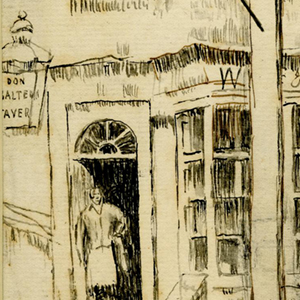Don Saltero's Coffee House
Names
- Don Saltero's Coffee House
- Museum Coffee House
- Saltero’s Coffee-house & Tavern
Street/Area/District
- Cheyne Walk
Descriptions
from London Signs, by Bryant Lillywhite (1972)
352 Don Saltero’s Coffee-house Chelsea c1690s–c1867. Also known as Museum Coffee-house; Saltero’s Coffee-house & Tavern; Don Saltero’s No.18 Cheyne Walk.
from London Coffee Houses, by Bryant Lillywhite (1963)
352. Don Saltero's Coffee House, Chelsea.
The history of this house is written by Timbs (1872): Wheatley (1891): Blunt in 'The Lure of Old Chelsea' (1922); Woodall in 'Country Life' (Jan. 28, 1954) and others. Discrepancies are to be found in these works.
'The Spanish Don'—Don Saltero, keeper of a Coffee House in Chelsea is listed in Evans Catalogue of Portraits, No. 21039.
Thornbury gives 1690 as the date of opening Salter's Coffee-house.
- 1695
- James Salter was for a time servant to Sir Hans Sloane. He is believed to have been of Irish descent and came to Chelsea about 1673–75. Two of his children were baptised at Chelsea in 1682 and 1687. Although the date is uncertain, Mr. Blunt considers that Salter first opened his coffee-house at the corner of Lawrence Street about 1695, and a few years later removed to a house on the west side of Danvers Street, near the river end of the Ferry where he remained until about 1717. He then removed to a house on the site of what is now No. 18, Cheyne Walk, and which was then the westernmost house of the row forming the Walk east of the Manor House. Caulfield's Memoirs of Remarkable Persons, vol. II, p. 134, mentions 'Salter, who kept a coffee-house on the banks of the Thames, Paradise-row, Chelsea ...'
Salter's first ventures appear to have combined a coffee-house and barber's-shop: famous for his punch, he entertained on the fiddle, shaved his customers, bled them, and drew their teeth for nothing. Sir Hans Sloane contributed unwanted items from his collection of curiosities to Salter, for the miscellaneous collection the latter was forming as an attraction to his coffee-house, - 1709–10
- and by the time Steele gave welcome publicity to the house by mention in the 'Tatler' 1709–10, the coffeehouse was almost absorbed by the museum. Steele is believed to have named him Don Saltero.
- 1717
- According to Blunt, Salter removed his house about 1717 to the site of the later known as No. 18 Cheyne Walk.
- 1723
- In 1723, Don Saltero, as he was then commonly known, issued a curious rhyming advertisement of his curiosities, headed 'Chelsea Knackatory' in which he mentions 'My Museum Coffee-house'.
- 1728–60
- James Salter died about 1728, when his daughter Mrs. Hall and her husband carried on the business till 1760. Between 1734 and 1760 a large number of Catalogues of the exhibits were printed. One for 1760 is described by Timbs, by which time it seems Mrs. Hall had converted the coffee-house into a show-place.
- 1778
- 'Saltero's Coffee House' is mentioned in Fanny Burney's first novel 'Evelina' published in 1778.
- 1786–1808
- As Don Saltero's Cheyne Walk, is listed in use for masonic lodge meetings by St. Luke's Lodge 1786–1808.
- 1799
- The house proved to be a great attraction and drew crowds until August 1799, when the collection of curiosities was sold, or dispersed. A copy of the Sale Catalogue is in the Chelsea Museum, and a description of Don SaItero's exhibits is to be found in the 'Gentleman's Magazine' for February, 1799. From 1799, the house continued as a Tavern, 'still bearing a green and gilt sign "Don Saltero's 1695".'
- 1807
- Timbs mentions that 'the Museum lacked the guiding imagination of' its founder ... and was dispersed by auction about the year 1807 ... and the quiet tavern remains'.
- 1809–38
- The house is listed in directories 1809 to 1838. In 1809–11 as Don Saltero's Coffee-house & Tavern. Proprietor—A. New. From 1833 to 1838 as Don Saltero's No. 18 Cheyne Walk. Proprietor—James Waldie.
- 1855
- In 1855 described by Timbs as 'the quiet tavern',
- 1867
- and Woodall mentions the house was rebuilt in 1867 and 'became No. 18, Cheyne Walk'.
